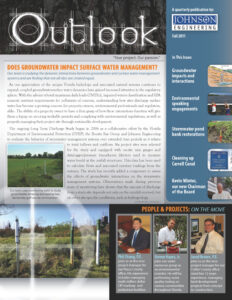 Our team is studying the dynamic interactions between groundwater and surface water management systems and is finding that not all sites are created equal.
Our team is studying the dynamic interactions between groundwater and surface water management systems and is finding that not all sites are created equal.
As our appreciation of the unique Florida hydrology and associated natural systems continues to expand, coupled groundwater-surface water dynamics have gained increased attention in the regulatory sphere. With the advent of total maximum daily loads (TMDLs), impaired waters classification and EPA numeric nutrient requirements for pollutants of concern, understanding how sites discharge surface water has become a growing concern for property owners, environmental professionals and regulators, alike. The ability of a property owner to have a firm grasp of how these interactions function will give them a leg-up on securing workable permits and complying with environmental regulations, as well as properly managing their project site through sustainable development.
The ongoing Long Term Discharge Study began in 2006 as a collaborative effort by the Florida Department of Environmental Protection (FDEP), the Bonita Bay Group and Johnson Engineering to evaluate the behavior of stormwater management systems over extended time periods as it relates to total inflows and outflows. Six project sites were selected for the study and equipped with on-site rain gauges and datalogger/pressure transducers (devices used to measure water levels) at the outfall structures. This data has been used to calculate flows and associated nutrient loadings from the systems. The study has recently added a component to assess the effects of groundwater interactions on the stormwater management systems. Observations made during previous years of monitoring have shown that the amount of discharge from a study site depends not only on the rainfall received, but on other site-specific conditions, such as hydrogeology.
During the first full year of monitoring in 2007, which represented the height of a multi-year drought, discharge only occurred at two of the six project sites, with no discharge through the outfall structures for the entire year from the four other project sites. Incidentally, the site receiving the highest rainfall amount was not one of the sites that discharged. Similar overall trends continued during the 2008 through 2010 monitoring periods, although more discharge events did occur due to higher rainfall amounts. Generally, the study sites tend to fall into either high or low discharge frequency categories. Sites in southern Lee and northern Collier Counties, in particular, discharge very infrequently, which suggests that groundwater interactions may play an important role in system function. Discussions with the FDEP and Bonita Bay Group regarding these discharge behaviors explored the benefits of adding a groundwater monitoring component to the study in order to assess the impacts of groundwater interactions.
The groundwater monitoring program, implemented in the spring of 2011, will develop site-specific data to be used in conjunction with existing and ongoing rainfall, surface water quality and discharge data collected within the study basins. The groundwater monitoring program will allow for a quantification of the volumes of groundwater moving into and out of the study basins, and the associated water quality. The groundwater monitoring program will also measure evapotranspiration (ET) directly at the study sites, something rarely done in this area. Evapotranspiration refers to the combination of water transmitted to the atmosphere via direct evaporation, such as from water bodies or the ground surface, and from transpiration by plants.
Two Bonita Bay communities in Fort Myers, The Verandah and Shadow Wood Preserve, were selected to represent the low and high discharge groups, respectively. Each site has been instrumented with a network of monitor wells and an ET gauge, in addition to the existing rainfall gauges and water level measuring devices on the outfall structures. Water levels at the monitor wells will be measured and compared to water levels in the stormwater lakes and lake discharge behavior. The monitor wells will also be sampled quarterly for a suite of water quality parameters of concern, similar to those collected from the lakes. Johnson Engineering will perform site-specific testing to determine aquifer characteristics and calculate the volume of groundwater entering and leaving the stormwater management lakes and moving between the water table aquifer and deeper aquifers underlying the project sites.
Using this data, Johnson Engineering will establish water budgets for each site. Typical water budgets are calculated by measuring components such as rainfall, irrigation usage and run-off, and attributing whatever deficit remains to ET—potentially up to 85% of losses from the water budget. Introduction of the ET gauge will enable Johnson Engineering to measure ET losses directly, which will serve as a check on other parts of the water budget and provide information on site-specific conditions. In addition to calculating water budgets for a study area, use of an ET gauge can also help residential developments, agricultural operations and golf courses better control their irrigation practices and make sure their projects have adequate irrigation allocations.
Ultimately, better understanding the dynamic interactions of surface water and groundwater will facilitate better stormwater management system design—for everything from water quality treatment to aesthetic considerations. Enhanced knowledge of how stormwater management lakes may function at a given site can also aid in selection of irrigation sources and strategies, such as whether to use recharge wells to supplement irrigation withdrawals from lakes, as if so, which well designs and locations will provide the most efficient and cost-effective use of the water.
For more information, contact Kim Arnold, P.G., at [email protected].































































